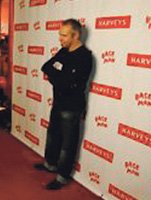For Harveys' Owners, Their Shop is Their Castle
The workplace should be as comfortable as a living room.
That’s the thinking behind Harveys owners Dana and Melanie Harvey’s decision to open their first boutique in a town house.
The three-story Harveys boutique celebrated its grand opening on Sept. 15 in the City Place shopping mall and residential development based in Santa Ana, Calif. The new City Place center opened in May and is located across the street from the Westfield Main Place shopping center. City Place features both residential and retail tenants. A Pinkberry yogurt store and a Coffee Bean & Tea Leaf cafeacute; will open soon.
Although mixed-use development has been growing in popularity, the notion of fashion stores doing business in town houses is still outside the norm, according to real estate experts.
The Harveys boutique is one of the first stores in City Place’s residential section town house development, where 72 out of the 185 town houses were zoned as live-work spaces, according to Bill Hammerstein, a partner in City Place developer Bisno Development Co. LLC. Contemporary-fashion boutique Hannah Bean opened a few storefronts away in another City Place town house.
Like mixed-use development, live-work spaces are also growing in popularity in Southern California. Areas such as Hollywood, West Hollywood and North Hollywood offer a few live-work developments, according to real estate consultant Larry Kosmont, president of Encino, Calif.–based Kosmont Cos.
The 1,600-square-foot Harveys town house was designed as a collection of three gallery shops by co-owner Dana Harvey. The New Zealand–born handbag designer and former vintage-clothing dealer said that he was involved with every step of building the store, from designing its look to hammering nails in the floorboards.
The first floor is a brightly lit space that features white walls and blonde-wood floors. This is the area where the company sells its most high-profile handbags, such as its collaboration with popular artist Gary Baseman, which debuted Sept. 15.
The second floor features design elements such as wood reclaimed from fences and distressed aluminum. It provides the backdrop to products including Harveys T-shirts and homewares. The third floor is a small lounge, which displays wares such as books and stuffed animals. Adjacent to the boutique, the Harveys will open Go Rilla, a three-story art gallery and concept store, which is scheduled to open by summer 2008.
The Harveys company plans to build more stores, Dana Harvey said. A San Francisco or Los Angeles boutique might open by summer 2008.
Dana Harvey did not initially aspire to get into the accessories business. In 1997, he made a handbag out of car seatbelts for his wife. Her friends requested that he make them seatbelt bags. By 2007, his crafts hobby had grown into a company with more than 56 employees. The brand’s seatbelt bags cost less than $300, but the company will experiment with a higher price point when it debuts leather bags for Holiday 2007, according to Melanie Harvey.
Some of the bags are limited-edition collectors’ items. Harveys’ first collectors’ bag debuted in February, and the graphics were designed by Santa Ana–based tattoo artist Sid Stankovitz.
The Baseman collaboration represents the artist’s first foray into accessories. In the past, Baseman designed art for video games, wrapping paper and boxes for mints. He said he appreciated the juxtaposition of his anarchic art with bags made out of seatbelts. “There’s a sense of chaos—with a beautiful sense of control,” Baseman said. —Andrew Asch























